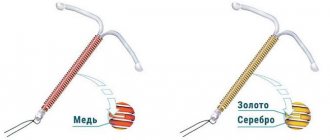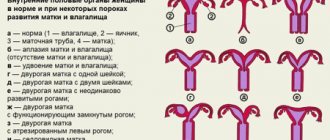06/25/2018 Category: Pregnancy Course Author: Larisa Morozova
The birth of a new life in a woman’s body is always a miracle. However, an even greater miracle is when the expectant mother finds out that the baby in her tummy is not alone. For many married couples, this comes as a complete surprise, while others deliberately want to give birth to twins. What are the specifics of multiple pregnancy, what risks does it carry? What should a woman prepare for?
- Classification of multiple births
Polyzygotic - Monozygotic
Video: why twins are born (Elena Malysheva’s TV program “Life is Great!”)
- Table: hCG norms during pregnancy with twins and one fetus
- Photo gallery: specifics of multiple pregnancy
- Video: natural birth or cesarean for twins? (doctor explains)
- Video: multiple pregnancy (mother shares experience)
How does multiple pregnancy occur?
Many women who have not had twins in their family are surprised when the doctor reports that they will become mothers of several babies at once. But for doctors there is nothing incredible here: although the genetic factor is important, this can happen to any woman, no matter what. Of course, multiple pregnancies are an extremely rare occurrence: there are only 3.5 cases per 1000 births. Among the factors that can increase the likelihood of such a pregnancy, the most often cited is the older age of the expectant mother - over 35 years old. This is also often caused by the IVF procedure (an egg is removed from a woman, fertilized and inserted into the uterus) or hormonal stimulation of ovulation, when several eggs mature in one cycle, and also if you have been taking oral contraceptives for a long time and have stopped doing so. .
Twins (aka twins) can be identical or fraternal.
- Fraternal twins can be formed due to the simultaneous fertilization of two mature eggs by the sperm of one or more men. In this case, eggs can mature in one or both ovaries.
- Interestingly, triplets and quadruplets can consist of identical or fraternal twins - as a rule, until the moment of birth, mom and dad cannot find out whether their babies will look the same or not.
- Identical twins do not always look alike, but they have the same skin color, hair, eyes, blood type, but their fingerprints are different. As a rule, a special emotional connection is established between them; they can simultaneously fall ill and recover, and have similar abilities.
Ifraternal twins may be different genders, just look a little alike, or look almost identical; identical - always only one gender: either girls or boys.
Risk factors for fetuses
Multiple pregnancy is not only difficult for the mother’s body (the likelihood of all kinds of complications doubles), but also carries quite high risks for babies:
- Developmental defects are recorded twice as often.
- Delayed development of one of the fetuses is recorded 10 times more often. If the twins are dichorionic, then this is 20% of children, if monochorionic - 30%. In general, the developmental delay of twins is 1.7% and 7.5%, respectively.
- Cerebral palsy develops 3–7 times more often in a child born from a mutt, and 10 times more often from a child born from triplets.
- Intrauterine mortality occurs 3–4 times more often.
The likelihood of fetal structural abnormalities is high if the twins are monozygotic (the risk increases by 2–3 times). If the twins are fraternal, then the probability is the same compared to a singleton pregnancy.
The main danger when carrying twins is disturbances in the circulatory system between the fetus and the placenta. Due to asymmetric blood circulation in the placenta (identical twins), blood flow to one of the fetuses may decrease (5–25% of cases). As a result, he does not receive enough nutrition: he suffers from hypoxia, lags behind in development, has much less weight and may even die. At this time, another child experiences hypertension, heart enlargement, etc. due to excess blood. In addition, there are cases of connection between large vessels, as a result of which blood from the artery of one child can enter the vein of another.
Due to uneven blood circulation or abnormal connections of blood vessels, one of the fetuses may receive less nutrition, lagging behind in development
What tests should you undergo if you are expecting twins?
As a rule, the doctor tells you that you will have twins at one of the first examinations: the uterus in this case is larger in size than during a normal pregnancy and grows faster. Sometimes a specialist is not immediately able to determine that a woman is expecting twins: they can “hide” behind each other. In other cases, the second egg dies in the first trimester, and the pregnancy becomes singleton. You need to prepare for more frequent examinations, and in this case there are more types of examinations themselves. As a rule, the doctor will wait for you every 10 days, and in the third trimester - every 7 days.
- At 10 weeks, you can do an electrocardiogram so that the doctor can hear the beating of several hearts in the uterus.
- At 8 to 12 weeks, an ultrasound also allows the doctor to detect a multiple pregnancy, although errors do occur. You will need to do this test once a month to monitor the normal function of the placenta.
- Be prepared for an obstetric examination at every visit to the doctor - all this is necessary to monitor the normal course of pregnancy.
- After the 30th week, in addition to ultrasound, Doppler sonography and cardiotocography of the fetus are performed; the regularity of the tests will depend on the course of pregnancy. They often need to be done weekly, and be prudent: if the doctor prescribes a temporary hospital stay for observation, then you need to follow his recommendation. Multiple pregnancy is a serious burden on the mother’s body, and in order for this process to proceed harmoniously, additional attention will clearly not hurt.
- You need to have your blood tested to prevent anemia: during multiple pregnancies, your hemoglobin level often drops.
In general, the health of a mother expecting twins or triplets will be the same. However, morning sickness, back pain, hemorrhoids and other pregnancy complications may appear earlier and be more pronounced.
Carrying several babies at once is a great joy, but a difficult test for the female body. It is very important to learn about complications in a timely manner in order to correct them. What do doctors fear besides miscarriage, genetic disorders and premature birth? Here's what you need to know.
1) Preeclampsia and preeclampsia
In multiple pregnancies, late toxicosis (preeclampsia) may develop, which can lead to increased blood pressure (preeclampsia). This entails a deterioration in the blood supply to both the placenta and the mother’s organs. Symptoms include severe swelling, dizziness and headache, nausea and vomiting, protein in the urine, blurred vision, and weight gain of more than 3.5 kg per week.
How to treat
This condition can only be alleviated until the end of pregnancy. Expectant mothers will have to test urine more often and reduce the amount of physical activity. If necessary, the doctor will admit you to the hospital.
2) Gestational diabetes
It can develop in pregnant women from 16 to 32 weeks (and go away after the end of pregnancy) and lead to preeclampsia. It is very important for mothers with diabetes to maintain normal blood glucose levels (3.5 - 5.5 mmol/l) and to know about the presence or absence of diabetes - after all, the baby’s body does not produce its own insulin until 12 weeks.
That's why your doctor will assess your risk of diabetes at one of your first appointments and prescribe regular blood sugar tests. If this disease is detected, mothers also need to pay attention to their health after childbirth: their risk of developing diabetes increases, regardless of pregnancy.
How to treat
Expectant mothers need to learn to control their diet, and in this case it will be possible to do without taking insulin. As a rule, the doctor recommends eliminating easily digestible sweets, replacing them with fruits, reducing the calorie content of food, as well as the amount of fat, consuming more fiber; the diet should be divided between carbohydrates, fats and proteins in proportions of 35 - 40%, 35 - 40% and 20 - 25%, respectively.
Don't get hung up on this information: every day women give birth to healthy twins. However, doctors must be fully armed.
Second trimester
- 13-16 weeks
The skeletal system of babies is actively developing. The rudiments of the ribs are formed. The bones of the skull become smooth and denser. Shallow breathing movements can already be observed. It's more like training your chest muscles. The digestive system begins to function. Peristaltic waves of the intestines appear. Bile production begins in the baby's liver. Interestingly, it is at this time that babies develop their sense of taste.
The movements of developing children in the uterus become increasingly active. They already have quite rich facial expressions, but so far they remain involuntary (children frown, smile, open their mouths, perform sucking movements).
The skin of babies is quite thin, blood vessels are clearly visible through it. There is practically no subcutaneous fat tissue. The scalp is gradually covered with the first vellus hairs.
The approximate size of 16-week-old babies is about 12 cm from rump to crown, and they weigh approximately 90 g each.
- 17-20 weeks
Children are growing actively. The growth of the body of children at this stage prevails over the growth rate of the head.
At the seventeenth week of pregnancy, the size of the babies from the sacrum to the crown is approximately 14-15 cm, each already weighs approximately 130-140 g.
Children at this stage of intrauterine development already hear and distinguish sounds and respond to them with certain movements. With loud, sharp sounds, babies move more intensely. Their eyes are still closed, but they can already distinguish between light and darkness. On an ultrasound, you can observe that the baby, in response to some external influences, tries to cover his face with his hands, bring his chin to his chest, that is, bend his head.
It has been proven that twins sense each other's presence.
As a rule, women carrying twins hear the first movements of the fetuses earlier than usual (16 weeks for first-time mothers, 18 weeks for repeat pregnant women). Since babies are cramped in the uterus, they push away from its walls more actively. At this stage, a woman can feel up to ten baby movements per day. At this stage, babies develop the blink reflex.
The fetal heartbeat can already be clearly heard with a phonendoscope or obstetric stethoscope. The rudiments of teeth, including permanent ones, are intensively formed. During this period, a cheese-like protective lubricant is formed on the fetal body. Subcutaneous fat tissue is formed.
Babies' bodies are already producing immune cells. Fetal hemoglobin is gradually replaced by adult hemoglobin.
By the end of the fifth month, the coccygeal-parietal size of the babies reaches 21-24 cm, and the weight is already quite decent - 320-340 g.
- 21-24 weeks
During this period, all pregnant women already felt the first movements of their babies. Baby's sleep time gradually decreases, and the time of wakefulness and active movements increases.
There is an active strengthening of bones. The skin is still wrinkled and has many folds; in large folds, especially a lot of cheese-like lubricant of the fetus accumulates.
The child actively swallows amniotic fluid containing particles of lubricant and desquamated epithelium, and dark green feces already accumulate in his intestines. In a normal pregnancy, bowel movements of babies can occur only after birth.
At this time, the amount of subcutaneous adipose tissue increases, including brown fatty tissue, which will protect babies from hypothermia after birth.
Babies are already very good at distinguishing sounds. It is noticeable that for themselves they identify sounds that are sharp, loud, pleasant or unpleasant, and react to them in a certain way (with excitement or freezing).
By the end of this period, the babies reach a height of 26-28 cm, their weight increases to 450-550 g.
- 25-28 weeks
The children’s facial features are becoming more and more clearly visible; they already have eyelashes and eyebrows. The curves of the ears gradually form.
The lungs are actively developing, so-called air sacs (alveoli) are formed. They are not yet filled with air, but at the 25th week a substance called surfactant begins to be produced, which will prevent these sacs from collapsing after birth, when they are filled with air.
Babies are actively gaining weight due to an increase in the amount of adipose tissue, muscle growth, growth and strengthening of bones.
During this period, boys' testicles begin to descend into the scrotum, and girls' genitals continue to form.
By the 28th week, as a rule, the final presentation of the fetuses is established, since they are already cramped in the uterus, they cannot turn over from the cephalic presentation to the pelvic presentation or vice versa.
By this period, babies are practically formed. In case of premature birth, with proper nursing, they are already quite capable of surviving.
By the end of this period, the weight of the babies is approximately 800-900 g, height up to 35 cm.
Changes in the body of the expectant mother of twins in the second trimester of pregnancy
The uterus has already grown enough, the tummy is noticeably rounded. At this stage, it is already more difficult for a pregnant woman to lead her usual active lifestyle. But proper alternation of periods of rest and activity will help avoid problems with constipation, varicose veins, and swelling.
During this period, the expectant mother should pay special attention to the diet, namely the sufficient content of protein and calcium in it. It is worth enriching the diet as much as possible with products containing calcium and phosphorus, vitamin D3 (fish, canned fish, eggs, nuts, hard cheeses, dairy products), since the skeletal system in children is actively developing. At this stage, the expectant mother may already be bothered by heartburn.
It's time to use a support bandage, since during this period most often the woman still has to work, and lower back pain and heaviness in her legs are already bothering her. The very physiologically changing gait (swinging) contributes to less strain on the back and pressure from the uterus on the pelvic bones. But in case of multiple pregnancy, it is difficult to do without additional support of the bandage.
Pregnant women often complain that it is difficult for them to find a comfortable position while sleeping. Experts recommend sleeping on your left side, with your upper leg bent at the knee and your lower leg straightened. Specially designed pillows for pregnant women are designed to relieve the pelvic bones and lower back and support a woman’s already enlarged belly.
Actively in the mammary gland, adipose tissue is replaced by glandular tissue. To the touch, the mammary gland has a fine-meshed structure.
Pigmentation of the parapapillary region on the chest and midline on the abdomen becomes more and more apparent. Pigment spots and freckles may appear on the body. This is due to an increase in melanin content in the skin of a pregnant woman.
Before the 22nd week of pregnancy, women undergo a second mandatory (screening) ultrasound. During this study, they may already be told the sex of the babies, if, of course, the position of twins allows them to consider their gender.
Premature birth: in what cases should you consult a doctor?
First of all, it is advisable to ask your doctor for a number that you can call at any time for consultations. Here are the sensations when you should consult a doctor or call an ambulance in case of acute symptoms:
- contractions resembling menstrual periods;
- pain in the lower abdomen, possibly with accompanying diarrhea;
- contractions of four or more within 20 minutes or eight or more within an hour;
- a feeling of pressure in the lower back that does not go away;
- unusual discharge;
- bleeding.
How to behave during multiple pregnancy
The most important thing for a mother who is expecting several babies at once is to calm down and not worry about anything. A good mood and a positive attitude are your concern.
- As soon as possible, visit several specialists and choose the one who seems to you to be quite competent, attentive, experienced and at the same time friendly and adequate. Your doctor should make you feel optimistic, and you will have to communicate with him frequently and trust him to manage your pregnancy. Remember that if at any stage you have a desire to change doctors, it is better to do so. We also advise you to write down your questions and feelings so that you can discuss them at your doctor’s appointment, and at the appointment, write down his advice. For forgetful pregnant women, this will help them not to miss anything.
- Form a healthy diet. Oddly enough, the weight gain of the expectant mother of twins is not so great: if during a normal pregnancy it ranges from 9 to 13–15 kg, then in the case of a multiple pregnancy it is 13–15 kg. So you don't have to eat for three or four. But it is very important to eat foods high in folic acid, iron and calcium.
- Do not take vitamins, herbal remedies or dietary supplements without consulting a specialist. Before you start taking any vitamins, tell your doctor thoroughly about your health, especially the medications you are taking (if you are taking them). Remember that a number of vitamins make it difficult to absorb other medications, and some medications, in turn, interfere with the absorption of vitamins, which means they need to be taken at different times of the day - so every nuance is important here.
- Give up bad habits. Avoid overheating whenever possible. Talk to your doctor about what type of physical activity and how much is good for you. Many doctors do not recommend expectant mothers of twins to exercise after the 24th week. Rest more often, monitor your health and remember: the better the mother’s physical condition, the stronger the baby’s health.
- This also applies to psychological health. Don't forget about walks with friends, pleasant conversations and your hobbies. Treat yourself and your well-being with care.
Closer to the due date, prepare to become a mother of twins: organize help with the babies after they are born - it is worth remembering that the emotional support of loved ones is also important. Don't try to embrace the immensity - don't hesitate to ask for help.
Don't expect twins to reveal their gender
No matter how much you strive to find out the gender of the babies, this will be problematic. When a doctor examines twins on an ultrasound to determine their gender, one of the babies can hide behind the other, the children turn away, cover themselves with their legs and arms, and constantly move.
As a result, the picture turns out blurry. Some parents do not know who will be born until the very birth.
How should a mother of future twins eat?
The expectant mother of twins needs to increase the number of calories in her diet by only 500 per day. What might they contain? For example, in one cheese sandwich and two glasses of low-fat milk or in a large orange and a handful of nuts. It's time to get acquainted with the table of calorie content of foods, which can be found on the Internet. If before pregnancy your diet was not the healthiest, don’t worry, but now you will eat right.
- The main thing is variety. Different foods provide different vitamins and minerals.
- Eat complex carbohydrates: vegetables, fruits, whole grains (pasta, brown rice, whole grain bread, oatmeal and other foods).
- Don't forget about protein and iron. It is better, if possible, to choose foods from which these elements are easily absorbed: dietary meat, chicken, tofu and other soy products, legumes, nuts, egg whites. If you don't eat meat, consult your doctor about your diet.
- Make sure you have enough calcium in your diet. Remember that for its absorption the body needs vitamin K2, which is found in Agusha curds, and vitamin D. Milk, cheese and yogurt are the best sources of calcium.
- Don't forget about healthy fats - vegetable oil, especially olive oil. There is also a lot of fat in nuts.
6. Try to control your diet
A strict diet will need to be followed for all 9 months. Although you need to eat for three, it’s not about the quantity of food, but about its quality. Eat small portions so as not to burden your stomach. Every day you need to consume about 3500 kcal.
Some products can be harmful to babies and therefore fall into the category of undesirables:
- sugar, baked goods, confectionery products cause weight gain (stress on the heart, bones, joints) and can cause allergies;
- salt also leads to increased body weight because it retains water in the cells;
- canned foods (sausages, smoked meats, pickled vegetables, all kinds of sauces) contain nitrites, flavor enhancers, other chemical hazards, and also cause heartburn;
- alcohol forces the mother’s body to spend vital energy on neutralizing its breakdown products, but this is not always possible; then babies develop congenital developmental pathologies.
What to expect after childbirth
Many mothers are scared that they will have to cope with several children at once. The main enemy of mothers with many children is perfectionism. Don't try to do everything - this can only lead to depression. Be sure to use the help of loved ones and a nanny, if you think this is possible, and devote time not only to your children and family, but also to yourself. Psychologists advise monitoring your mood very carefully to avoid the consequences of excessive stress. By the way, many people find it helpful to meet “lucky friends” - other mothers of twins with whom they can exchange experiences. Here's what they note:
- It is necessary to establish a feeding and sleeping schedule as soon as possible, otherwise you will not be able to cope with twins. Of course, a perfectly synchronized routine only happens in fairy tales, but you can try to get closer to such a situation;
- If you want, you can breastfeed two babies at the same time - this is possible. But some mothers prefer to feed their babies in turns. Remember that there are professional lactation consultants - make an appointment with one;
- When raising, support differences between children, especially identical ones, so that they feel like separate individuals. It is advisable to encourage them to have different friends, hobbies and social circles.
Good news: the older the kids, the easier it is with them. By age 2, you will find that they sleep better in the same room and enjoy playing with each other.
Main hazards
Multiple pregnancies always carry a high risk of complications for both the mother and the developing fetus.
The most common problems are::
- incorrect presentation of fetuses;
- polyhydramnios;
- placenta previa;
- increased fatigue, weakness, shortness of breath;
- anemia;
- prematurity;
- developmental abnormalities of one or both fetuses.
To avoid complications, a woman is advised to follow all doctor’s orders and be attentive to her health.
What purchases will parents of twins have to make?
According to the experience of parents, twins do not need many identical things; some things can be bought in one copy.
- Children only need one crib, one changing table, one bathtub, one comb and nail clippers, as well as one baby monitor and other similar items.
- If you want to buy two developmental mats, two mobiles or two walkers at once, it’s better not to do this. One of the kids may not like the toy, so it is better to buy such things, at least at first, in one copy. If children cannot share a toy, then you can buy a second one of the same kind.
- Children need different car seats, high chairs and stroller seats.
- Buy diapers, wipes and baby food in one place and make sure you get a discount card.
- Remember that you don’t need to buy a lot of clothes for newborns: babies quickly outgrow them.
Don't self-medicate
Taking vitamin and mineral supplements without consulting your obstetrician is a bad idea. The fact is that if you have toxicosis (and other factors), you cannot take vitamins, and some of them are permissible only for a certain period of time.
Pay special attention to taking medications. We discuss any prescription from the point of view of danger for children, and then at home we carefully read the instructions, even for ointments. It happens that the doctor misses some factor.
Double-check the contraindications and administration details yourself.
Maternity leave, benefits and payments for multiple pregnancies
The procedure for applying for maternity leave and receiving payments is the same for pregnant women, regardless of how many babies they are expecting. We talk about these procedures in detail here. However, some payments to expectant mothers of twins are structured differently.
- If a woman is pregnant with twins, maternity leave increases from 140 to 194 days. If the fact that the pregnancy is multiple is established after the sick leave has been issued, the maternity hospital or other medical organization will issue an additional certificate of incapacity for work.
- In 2021, the one-time benefit is 15,512 rubles 65 kopecks for each child.
- Monthly child benefit is paid until the child reaches 1.5 years of age. The amount is 40% of a woman’s average earnings, and for an unemployed mother of twins it is minimal and equal to 2,718 rubles 34 kopecks per month for the first child and 5,436 rubles 67 kopecks for the second and third children.
It is also important that each region has its own additional payments for mothers of twins - as a rule, this is a monthly payment for the third and each subsequent child. It corresponds to the minimum subsistence level and is carried out until the age of three of each child.
We wish you an easy pregnancy and successful childbirth!
Identical twins
In fraternal twins, each fetus develops from a separate egg and has its own placenta and amnion. In identical twins, the fertilized egg, only after merging with the sperm, is divided into two or more parts, each of which begins to form as an independent organism, while they will have a common amniotic sac and placenta. As a result, children are born with an identical set of genes. This pregnancy is called monochorionic diamniotic.









